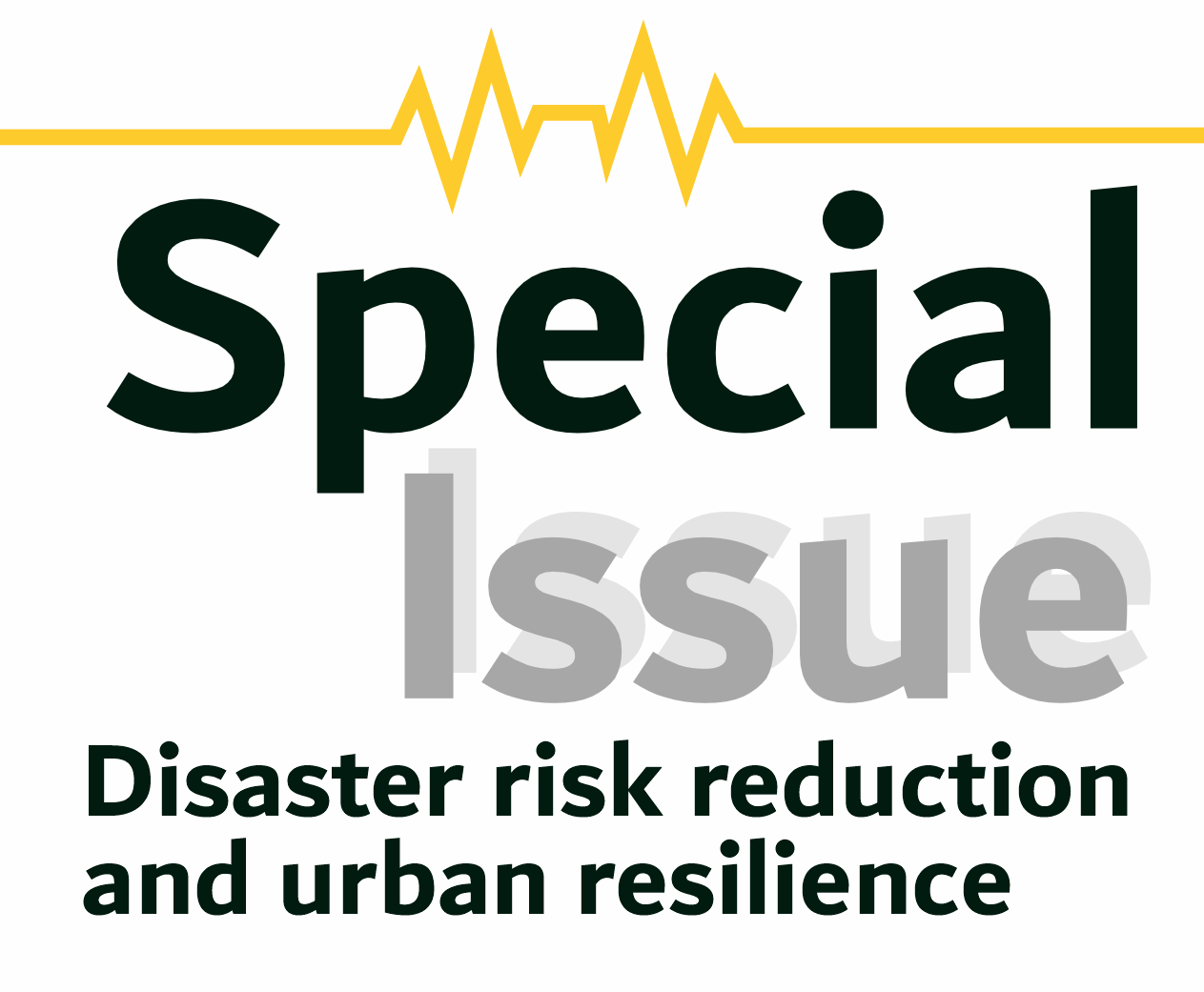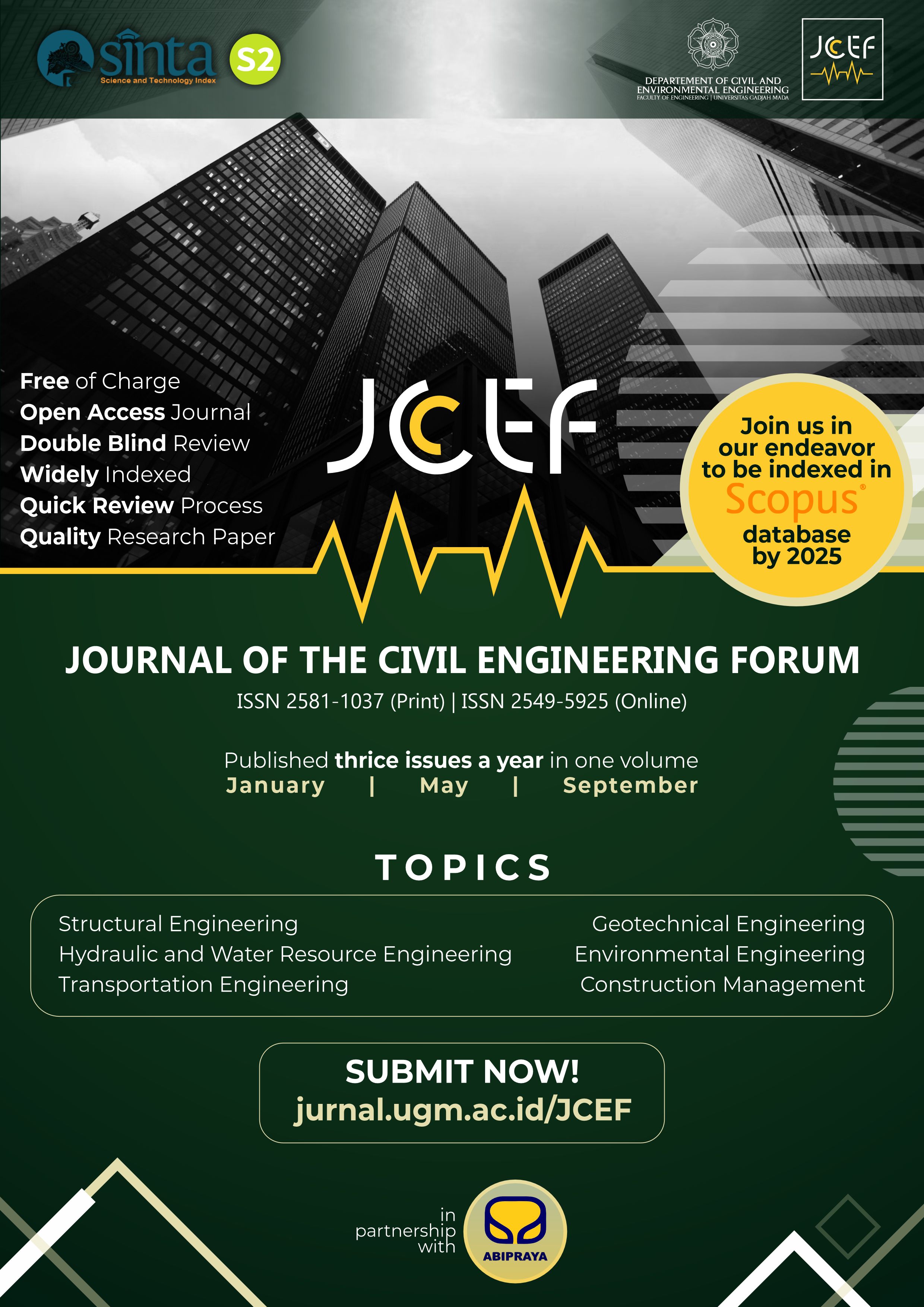Implementation of Agent Based Modelling to Observe the Evacuating Behavior at Faculty of Engineering Building, University of Bengkulu, Indonesia
Abstract
Evacuation is an important issue during the occurrence of an earthquake, due to the influence of people’s responsive behaviours to the disaster. This indicates the occurrence of overcrowded conditions, which causes the conflict of people’s movement. It is also one of the main reasons the process of evacuation is difficult, leading to the necessity to specifically model the movement within each building. Therefore, this study aims to analyze the earthquake evacuation modelling in Faculty of Engineering building, University of Bengkulu, Indonesia. This used a multi-agent programmable modelling environment known as NetLogo, which adopted an ABM model that is often utilized to observe elemental movement response. The agents occupying the building also moved to the stairs and evacuation doors, for exit towards the assembly point, which was located in front and behind Faculty of Engineering. The agent-based modelling is then conducted by inputting the layout of the building and the number of occupants in each room. Furthermore, the simulations were performed by considering various agents’ capacity in the building, during the evacuation. The results showed the time taken for the agents to exit the building during the disaster. This confirmed that the required exit time generally decreased with the increasing population percentage in the building. During this process, the conflict point also occurred around the corridor of Floors 1 and 2 (T1, T2 and T3), as well as the exits of the building (P1, P2, P3, and P4). This was due to the occurrence of a high density when agents carry out evacuation movements. Based on these results, the placement of signs was recommended, as guidelines during the evacuation process.
References
Arai, R., Takahashi, T., Kodaira, S., Kaiho, Y., Nakanishi, A., Fujie, G., Nakamura, Y., Yamamoto, Y., Ishihara, Y., Miura, S. et al. (2016), ‘Structure of the tsunamigenic plate boundary and low frequency earthquakes in the southern ryukyu trench’, Nature Communications 7(1), 1–7.
Bonabeau, E. (2002), ‘Agent-based modeling: Methods and techniques for simulating human systems’, Proceedings of the national academy of sciences 99(suppl 3), 7280–7287.
Cegielski, W. H. and Rogers, J. D. (2016), Rethinking the role of agent-based modeling in archaeology’, Journal of Anthropological Archaeology 41, 283–298.
Edara, P., Sharma, S. and McGhee, C. (2010), ‘Development of a large-scale traffic simulation model for hurricane evacuation—methodology and lessons learned’, Natural hazards review 11(4), 127–139.
Farid, M. and Mase, L. Z. (2020), ‘Implementation of seismic hazard mitigation on the basis of ground shear strain indicator for spatial plan of bengkulu city, indonesia’, GEOMATE Journal 18(69), 199–207.
Hardiansyah, Muthohar, I., Balijepalli, C., Priyanto, S. et al. (2020), ‘Analysing vulnerability of road network and guiding evacuees to sheltered areas: Case study of mt merapi, central java, indonesia’, Case studies on transport policy 8(4), 1329–1340.
Hardiansyah, Priyanto, S., Muthohar, I. and Suparma, L. B. (2019), ‘Identifying road network vulnerability during disaster case study: Road network evacuation in mount merapi eruption.’, Songklanakarin Journal of Science & Technology 41(4).
Helbing, D. (2012), Agent-based modeling, in ‘Social self-organization’, Springer, pp. 25–70.
Hinga, B. D. R. (2015), Ring of Fire: An Encyclopedia of the Pacific Rim’s Earthquakes, Tsunamis, and Volcanoes: An Encyclopedia of the Pacific Rim’s Earthquakes, Tsunamis, and Volcanoes, ABC-CLIO.
Isaac, S. and Michael, W. B. (1995), Handbook in research and evaluation: A collection of principles, methods, and strategies useful in the planning, design, and evaluation of studies in education and the behavioral sciences, Edits publishers.
Ishii, M., Shearer, P. M., Houston, H. and Vidale, J. E. (2005), ‘Extent, duration and speed of the 2004 sumatra andaman earthquake imaged by the hi-net array’, Nature 435(7044), 933–936.
Janssen, M. A. (2005), ‘Agent-based modelling’, Modelling in ecological economics 155(1), 172–181.
Kasereka, S., Kasoro, N., Kyamakya, K., Goufo, E.-F. D., Chokki, A. P. and Yengo, M. V. (2018), ‘Agent-based modelling and simulation for evacuation of people from a building in case of fire’, Procedia Computer Science 130, 10–17.
Lay, T., Kanamori, H., Ammon, C. J., Nettles, M., Ward, S. N., Aster, R. C., Beck, S. L., Bilek, S. L., Brudzinski, M. R., Butler, R. et al. (2005), ‘The great sumatra-andaman earthquake of 26 December 2004’, Science 308(5725), 1127-1133.
Likert, R. (1932), ‘A technique for the measurement of attitudes.’, Archives of psychology .
Manandhar, B. (2016), ‘Remittance and earthquake preparedness’, International Journal of Disaster Risk Reduction 15, 52–60.
Mase, L. Z. (2018), ‘Reliability study of spectral acceleration designs against earthquakes in bengkulu city, indonesia’, International Journal of Technology 9(5).
Mase, L. Z. (2020), ‘Seismic hazard vulnerability of bengkulu city, indonesia, based on deterministic seismic hazard analysis’, Geotechnical and Geological Engineering 38(5), 5433–5455.
Mase, L. Z. (2021), ‘A note of ground motion interpretation and site response analysis during the 2007 bengkulu–mentawai earthquakes, indonesia’, Arabian Journal of Geosciences 14(2), 1–14.
Mase, L. Z., Sugianto, N. et al. (2021), ‘Seismic hazard microzonation of bengkulu city, indonesia’, Geoenvironmental Disasters 8(1), 1–17.
Misliniyati, R., Mase, L., Syahbana, A. and Soebowo, E. (2018), Seismic hazard mitigation for bengkulu coastal area based on site class analysis, in ‘IOP Conference Series: Earth and Environmental Science’, Vol. 212, IOP Publishing, p. 012004.
Nabila, F., Mase, L. Z. et al. (2020), ‘Numerical analysis using agent based modelling for tsunami hazard evacuation at building i, university of bengkulu, indonesia’, Potensi: Jurnal Sipil Politeknik 22(1), 21–32.
Norio, O., Ye, T., Kajitani, Y., Shi, P. and Tatano, H. (2011), ‘The 2011 eastern japan great earthquake disaster: Overview and comments’, International Journal of Disaster Risk Science 2(1), 34–42.
Nur, A. M. (2010), ‘Earthquake, tsunami and their mitigation’, Journal of Geography, Information Media, Geographical Development and Profession 7(1).
Pratama, D. P., Afrizal, Y., Mase, L. Z. et al. (2020), ‘Implementation of agent based modelling method for tsunami hazard evacuation in building j, university of bengkulu, bengkulu, indonesia’, Potensi: Jurnal Sipil Politeknik 22(2), 114–122.
Proulx, G. (2001), Occupant behaviour and evacuation, in ‘Proceedings of the 9th international fire protection symposium’, Citeseer, pp. 219–232.
Putera, R. E., Nurasa, H. and Sugandi, Y. S. (2018), ‘Synergizing stakeholders in reducing risk of earthquake and tsunami-disaster in the most vulnerable area’, BISNIS & BIROKRASI: Jurnal Ilmu Administrasi dan Organisasi 23(3).
Railsback, S. F. and Grimm, V. (2019), Agent-based and individual-based modeling: a practical introduction, Princeton university press.
Reyes, M. and Miura, F. (2016), A proposal for qualitative and quantitative analysis methods for vertical evacuation from a tsunami in coastal cities, in ‘Coastal Management: Changing coast, changing climate, changing minds’, ICE Publishing, pp. 97–107.
Richiardi, M. G. (2017), ‘The future of agent-based modeling’, Eastern Economic Journal 43(2), 271–287.
Sahroli, A. and Hardiansyah, H. (2019), ‘Analysis of tsunami disaster evacuation in the joint lecture building v, bengkulu university with abm method’, Inertia: Journal of Civil Engineering 11(2), 25–33.
Tumewu, T. W. (2017), ‘Agent-based simulation for disaster evacuation of indoor field crowd gor x’, Widya Teknik 15(1), 41–45.
Wood, N., Jones, J., Schmidtlein, M., Schelling, J. and Frazier, T. (2016), ‘Pedestrian flow-path modeling to support tsunami evacuation and disaster relief planning in the us pacific northwest’, International Journal of Disaster Risk Reduction 18, 41–55.
Copyright (c) 2022 The Author(s)

This work is licensed under a Creative Commons Attribution-ShareAlike 4.0 International License.
Copyright is granted to authors for the purpose of providing protection for articles written to describe experiments and their results. JCEF will protect and defend the work and reputation of the author and are also willing to address any allegations of violation, plagiarism, fraud, etc. against articles written and published by JCEF. JCEF is published under the terms of the Creative Commons Attribution-ShareAlike 4.0 International License (CC BY-SA 4.0). The author holds the copyright and assigns the journal rights to the first publication (online and print) of the work simultaneously.





